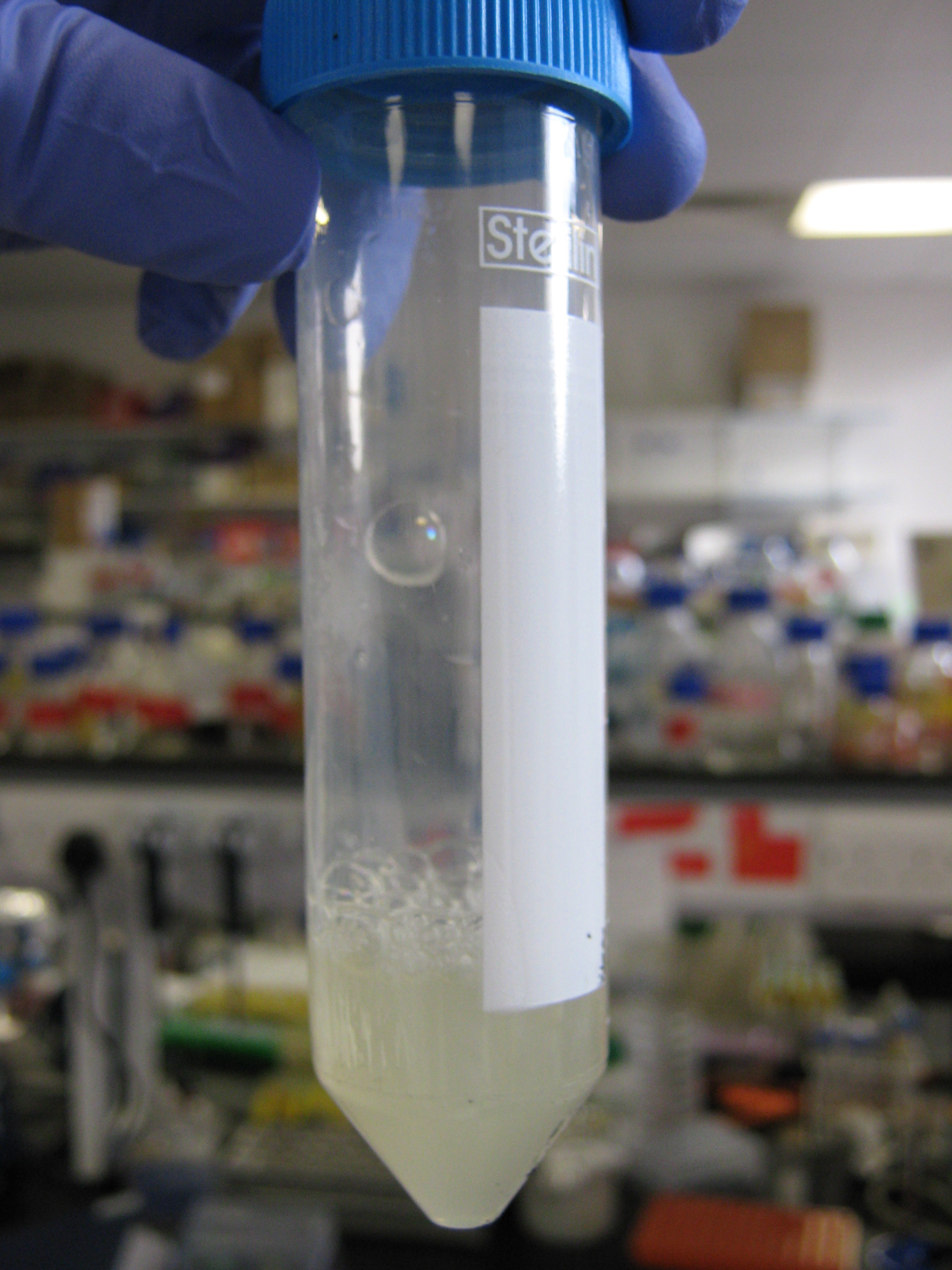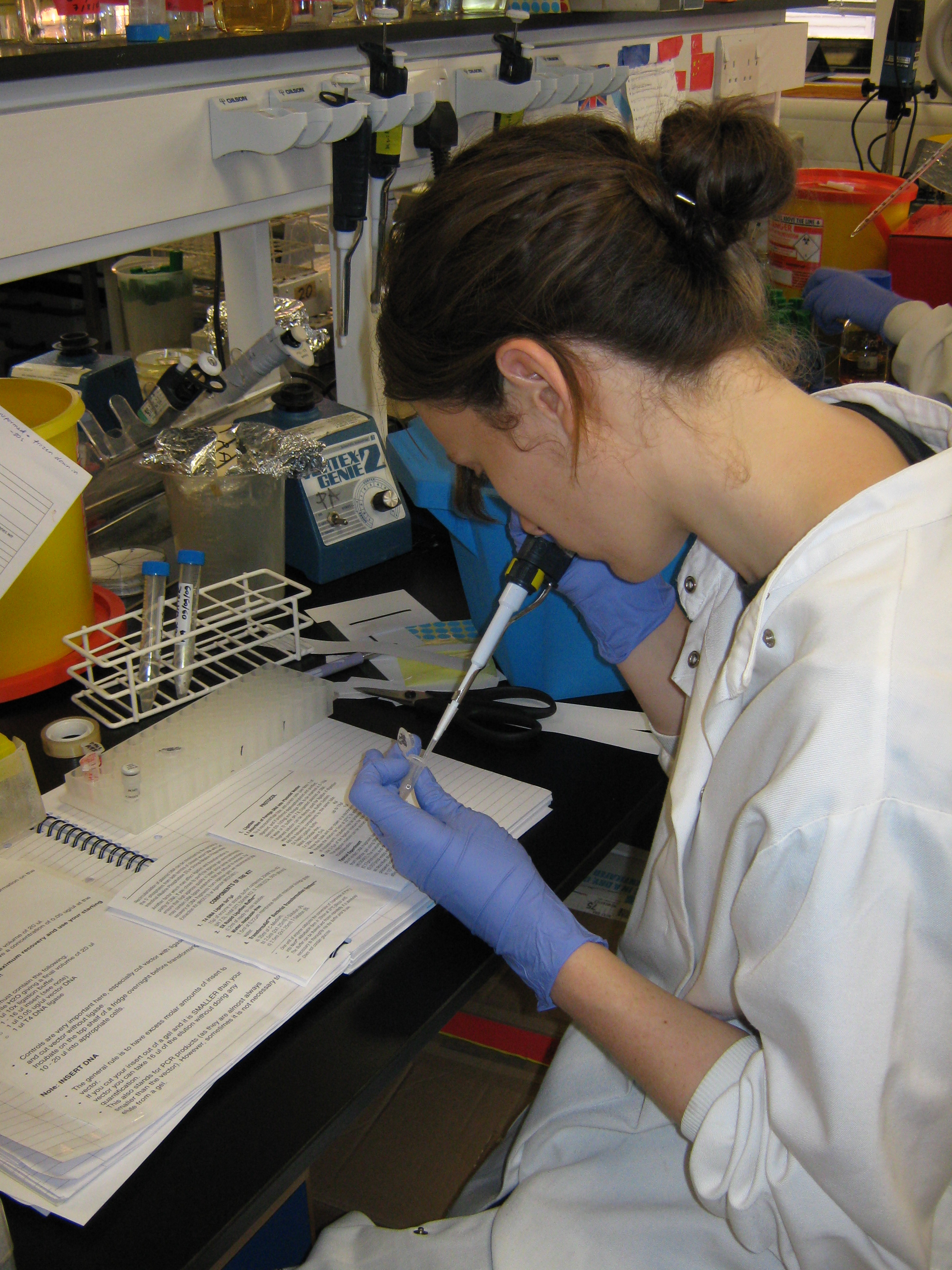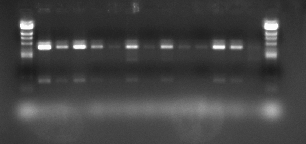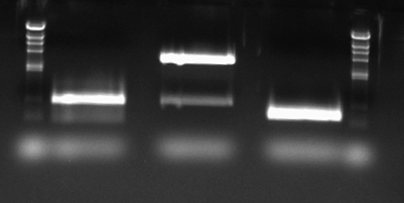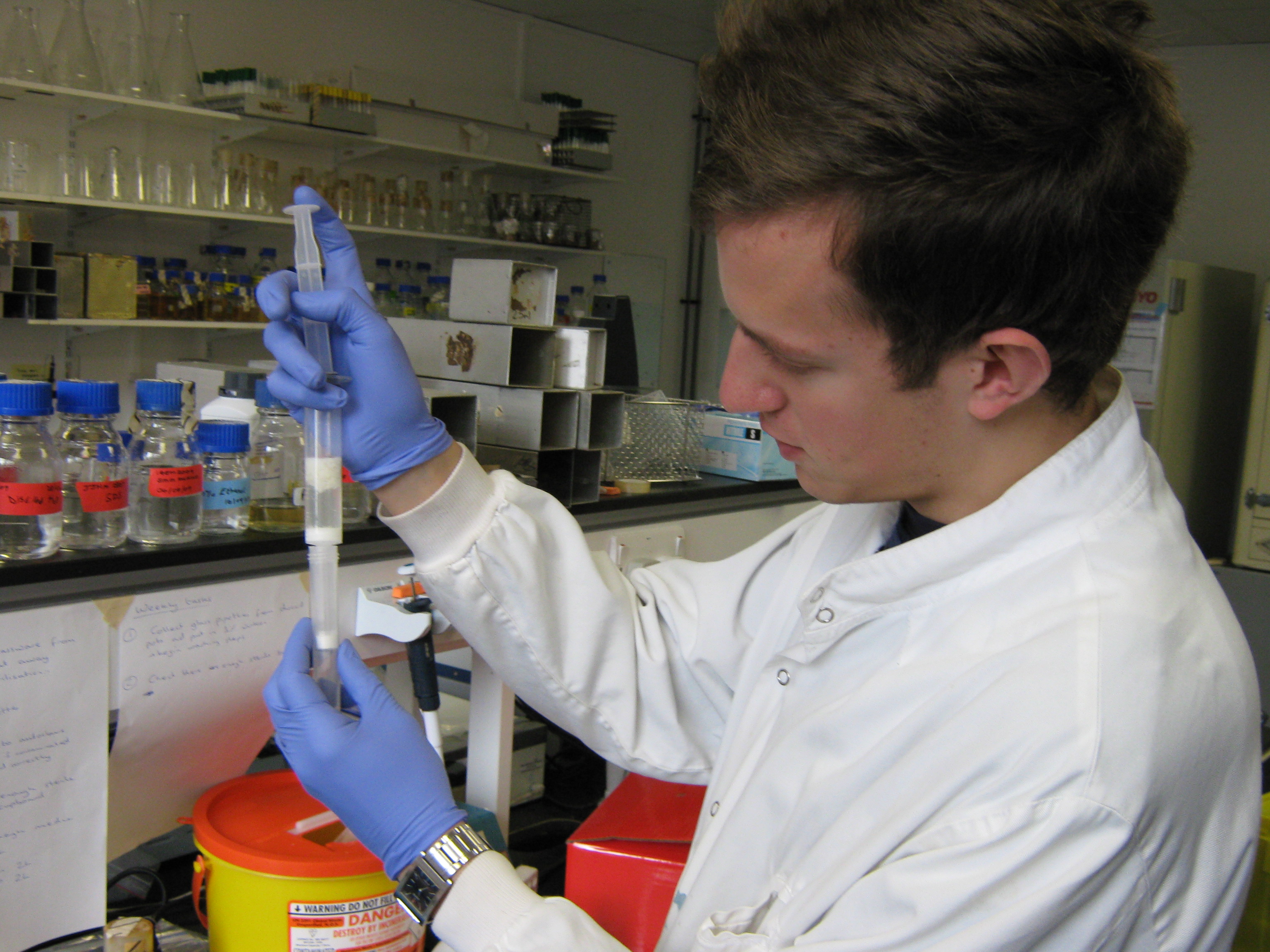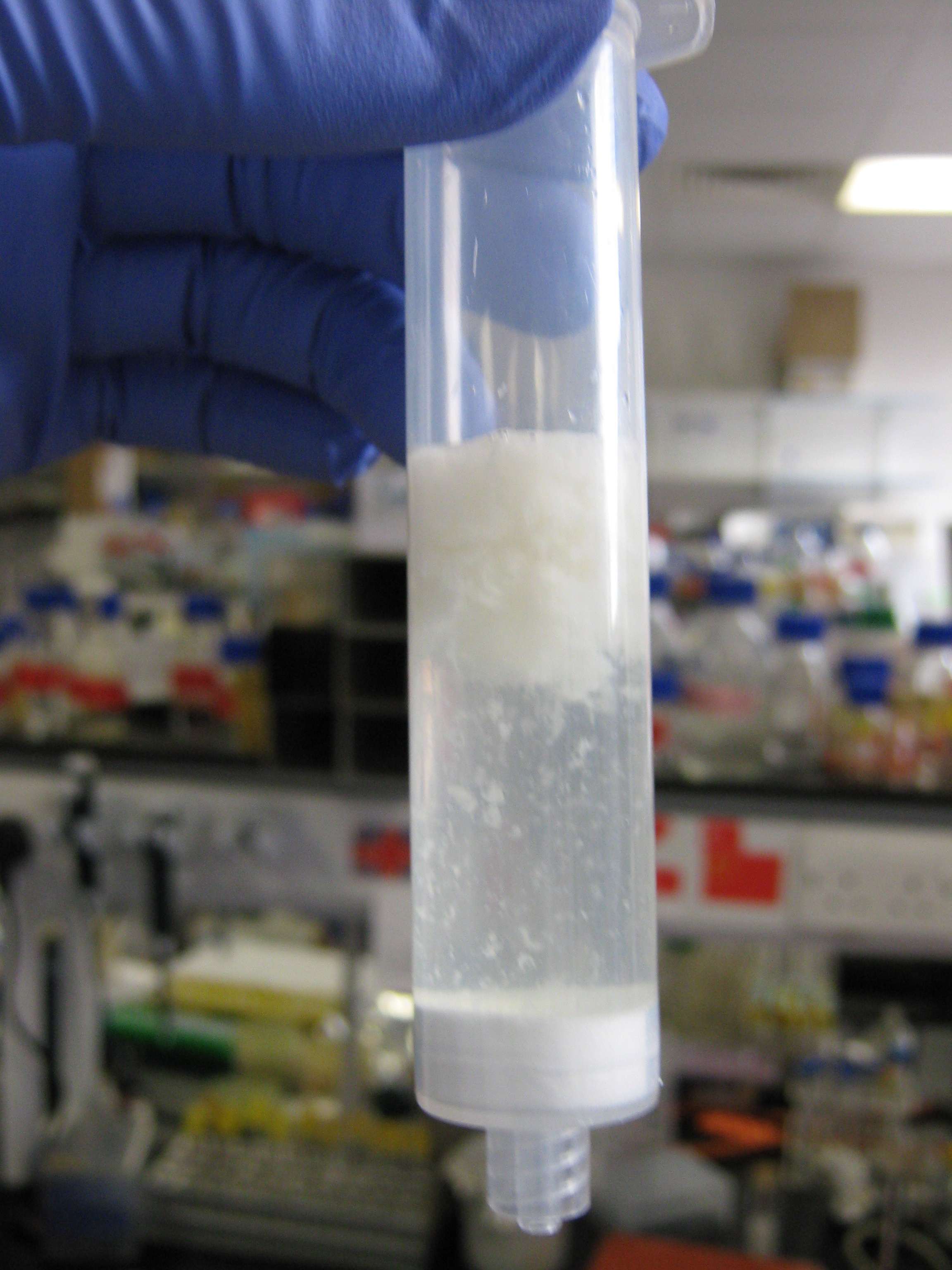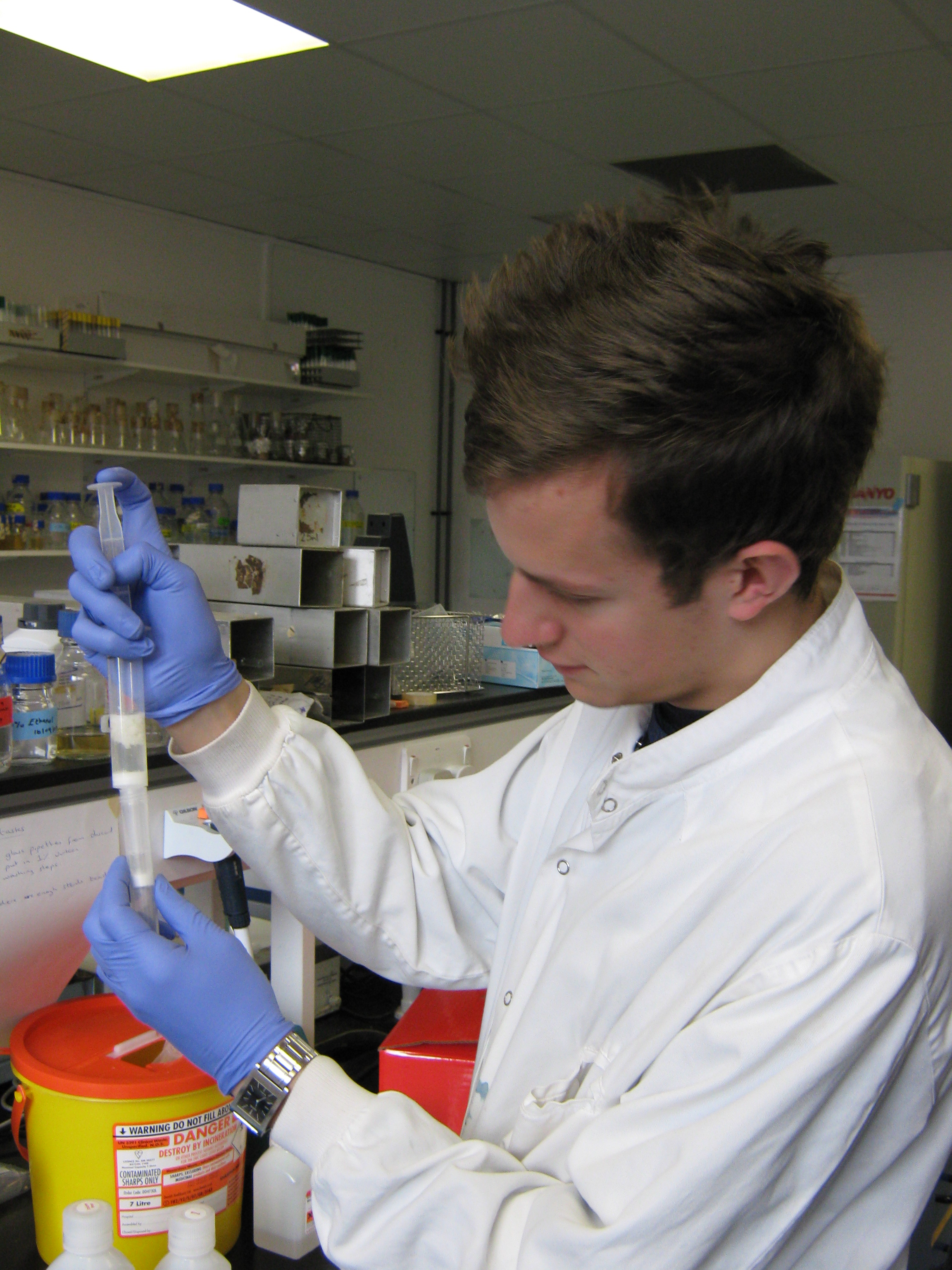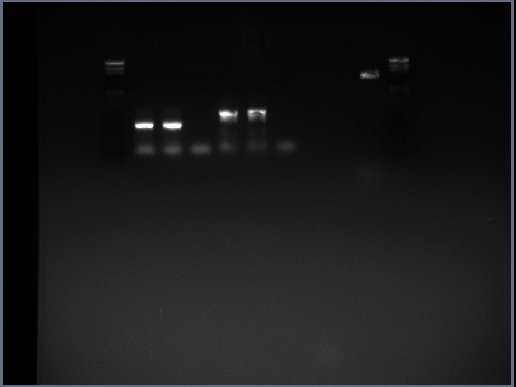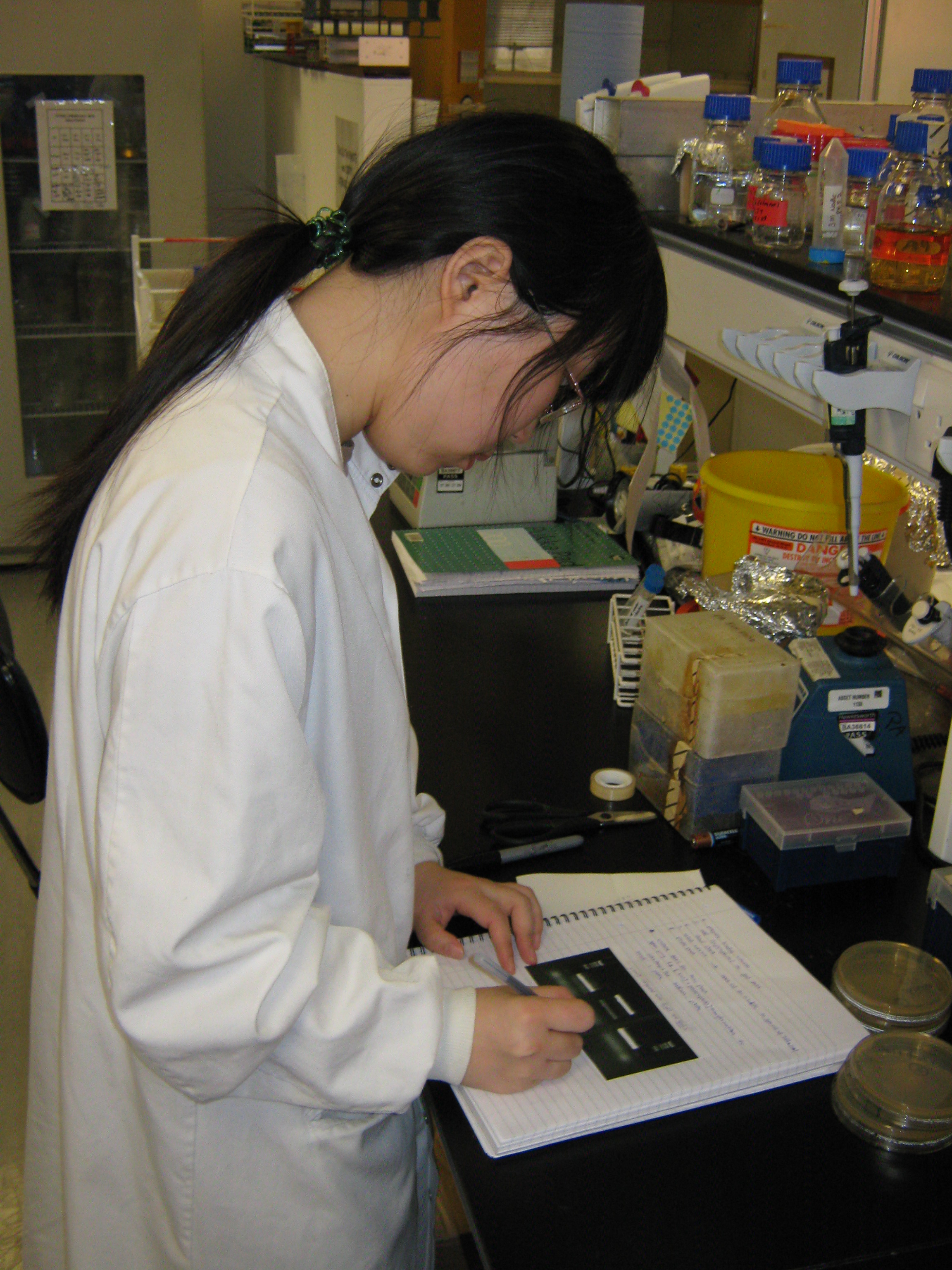Team:Newcastle/Labwork/17 September 2009
From 2009.igem.org
Formal Lab Session - 17th September 2009
Overview
Stochastic Switch Team
Today we ran the minipreps for sac and ara transformed cells however- perhaps due to poor miniprep procedure- the sac test digest yeilded poor results, however the ara transformants miniprep gave a ~200bp band along with the backbone in 8/12 lanes:
Midi prep cultures were set up using cultures corresponding to lanes 1 and 3 for ara.
To test whether the poor sac result was due to the miniprep more miniprep cultures were set up to do tomorrow.
Today also we did fragment preps for Goksels sspb the ara fragment, and a cwlJ fragment for Hanny:
Metal Sensor Team
Introduction
In yesterday's lab session the Metal Sensing team carried out mini-preps on the 12 colonies of potential cotC-GFP-smtA E. coli transformants and analysed them. Despite them showing incorrectly sized bands when digested and ran on gel, the team proceded to carry out preparations to midi-prep colony 8 on the basis of consistency of the band patterns and the theory that the digests may not have worked properly. The midi-prep will be done today.
The team also prepared to ligate the cadA promoter to the BBa_J33206 BioBrick (which contains the arsR gene and arsR binding site and has the promoter cut out) but only got as far as digesting the two fragments. The cadmium-sensor has been put on hold as of the General Meeting on 16/09/09.
Additionally the metal sensing team prepared for transformation in Bacillus subtilis by carrying out the evening steps of the protocol - this will mean that if the midi-preps are a success then B. subtilis can be transformed with cotC-GFP-smtA in pMUTIN4 today!
Today's lab work will focus on midi-prepping colony 8 (which is a potential cotC-GFP-smtA transformant E. coli colony). The DNA will then be analysed by digesting a sample with BamHI and HindIII and running it on agarose gel through DNA gel electrophoresis. If successful, the DNA will be used to transform B. subtilis cells; if unsuccessful the ligations of pMUTIN4 to cotC-GFP-smtA will have to be repeated on another day.
Practical Outline
The tasks the Metal Sensing team hope to carry out by the end of the day include the following:
- Midi-prep colony 8 of the potential cotC-GFP-smtA transformant E. coli DH5-alpha cells.
- Digest the midi-prepped DNA with BamHI and HindIII
- Analyse the digested products through DNA gel electrophoresis:
- If successful, use midi-prepped DNA to transform Bacillus subtilis
- If unsuccessful, prepare to carry out a second attempt at ligating cotC-GFP-smtA to pMUTIN4.
Procedure
1) Midi-prep of potential cotC-GFP-smtA transformant E. coli cells
To carry out the midi-prep we used Sigma-Aldrich's GenElute HP Midi-prep kit (and the protocol attached to it). We conducted steps 1-6 and then steps 7b to 11b (the Spin Method) followed by the DNA concentration step. There was only one major change to the protocol:
- For the DNA concentration step instead of transferring the eluted DNA to one centrifuge tube, the DNA was transferred into two Eppendorf tubes. This change means that we now have access to a centrifuge capable of reaching 13,000rpm; if we had stuck to using the centrifuge tubes described in the protocol then we wouldn't be able to reach the required g-force.
Once the midi-prep process was completed the DNA was placed in the -20ºC freezer.
2) Analysis of midi-prep DNA
a) Quantifying the DNA
The midi-prep DNA, which was now stored in two Eppendorf tubes, was then analysed using the NanoDrop spectrophotometer to check for DNA. The concentrations of DNA in the 2 Eppendorf tubes were as follows:
- Eppendorf tube 1 = 118.9ng/ul
- Eppendorf tube 2 = 100.7ng/ul
In total, that means we have 219.6ng/ul of plasmid DNA. In the 40ul of solution that means we have 8.784 micrograms of DNA in total. This is sufficient for Bacillus subtilis transformations.
b) Digesting the midi-preps
A sample of the midi-prep DNA was then digested with BamHI and HindIII restirction enzymes. The contents of the digest reaction were as follows:
- 10ul of midi-prep DNA
- 1ul of FastDigest HindIII restriction enzyme
- 1ul of FastDigest BamHI restriction enzyme
- 2ul of FastDigest 10x restriction buffer
- 6ul of sterile distilled water
The digests were allowed to run for 1 hour under 37ºC incubation (regulated by water bath)
c) DNA gel electrophoresis
The digested midi-prep sample was then run on agarose gel in DNA gel electrophoresis - this sample was accompanied by DNA samples from the Sporulation team. The electrophoresis was allowed to commence for 30 minutes under 80 volts to yield the following GelDoc photograph:
The sample that our team is interested in is the single sample on the right hand side. This gel photograph shows two clear faults making analysis very difficult and almost impossible:
- The DNA HindIII ladder has either degraded or has been made up incorrectly.
- The desired clarity of the bands has not been reached.
In light of this unsuccessful DNA gel electrophoresis procedure, the Metal Sensing team will have to carry out this task tomorrow with a different DNA ladder and with better-made gel.
3) Bacillus subtilis transformations
Due to the unsuccessful DNA gel electrophoresis, we are unable to determine whether the midi-prep DNA is really the cotC BioBrick held inside the pMUTIN4 plasmid. Because of this we will have to postpone the Bacillus subtilis transformations until tomorrow. The overnight cultures, which were set up yesterday, were discarded and fresh overnights were set up according to the "Evening before transformations" steps of the Bacillus subtilis protocol.
Sporulation Tuning/Chassis Team
Introduction
- Good news for yesterday's transformation, both cwlJ + pSB1AT3 and cwlJ + pSB1AT3:sleB did work and we got some colonies on antibiotic plates.
- As a back plan, we did a normal ligation today for transformation.
- Also we digest cwlJ PCR result with EcoRI and SpeI in case we may perform another ligation and transformation.
- Our plan B for double clone is:
- PCR sleB and cwlJ
- Digest sleB with XbaI
- Digest cwlJ with SpeI
- ligate sleB and cwlJ together
- PCR our ligated cwlJ and sleB with primer cwlJForward and sleBReverse
- Digest PCR result by EcoRI and SpeI and ligate to pSB1AT3
Experiment procedure
Digest cwlJ PCR result
- The PCR result came from No.5 clean up DNA which was PCRed on day 11/09/09.
- Prepare the digest reaction.
dd H2O 7ul
10X fast digest buffer 7ul
Fast EcoRI 3ul
Fast speI 3ul
cwlJ DNA 50ul
------------------------------
70ul
Prepare cwlJ and sleB fragment for Plan B
- Prepare buffer mix and Taq
For Go Taq
Reaction buffer 10ul x 8 = 80ul
dNTP 2ul x 8 = 16ul
--------------------------------
96ul
12ul for each reaction
GoTaq(5U/ul) 0.25ul x 6 = 1.5ul
ddH2O 10.5ul
----------------------------------
12ul
2ul for each reaction
| No. | Water (ul) | PCR Mix (ul) | Forward Primer (ul) | Reverse Primer (ul) | Template (ul) | Polymerase used (ul) | Total Volume (ul) |
|---|---|---|---|---|---|---|---|
| 1 | 29 | 12 | cwlJForward 2.5ul | cwlJReverse 2.5ul | cwlJ PCR result 2ul | GoTaq 2ul | 50 |
| 2 | 29 | 12 | cwlJForward 2.5ul | cwlJReverse 2.5ul | cwlJ PCR result 2ul | GoTaq 2ul | 50 |
| 3 | 31 | 12 | cwlJForward 2.5ul | cwlJReverse 2.5ul | 0 | GoTaq 2ul | 50 |
| 4 | 29 | 12 | sleBForward 2.5ul | sleBReverse 2.5ul | B.Subtilis 168 | GoTaq 2ul | 50 |
| 5 | 29 | 10 | sleBForward 2.5ul | sleBReverse 2.5ul | B.Subtilis 168 | GoTaq 2ul | 50 |
| 6 | 31 | 10 | sleBForward 2.5ul | sleBReverse 2.5ul | 0 | BioTaq 2ul | 50 |
- PCR procedure: STD50
95C 2min -->[95C 30S --> 50C 30S --> 75C 1min] 30 runs --> 75C 5min --> store at 4C
Normal Ligation
This ligation is a back up for cwlJ transformation.
- L3: Ligation reaction
dd H2O 0.5ul
ligation buffer 2ul
digested cwlJ 16ul
digeste pSB1AT3 0.5ul
T4 ligase 1ul
--------------------------------
20ul
- L3 control
dd H2O 1.5ul
ligation buffer 2ul
digested cwlJ 16ul
digeste pSB1AT3 0.5ul
--------------------------------
20ul
- Put the reaction tubes on top shelf of frige overnight.
Gel extraction
- After 1 hour digestion of cwlJ, we purified cwlJ by gel extraction kit alone with two other digested sample (Goksel's and Jess's)
Culture L1 and L2 transformation cells for Mini Prep
- Add 5ml liquid LB+Amp+Tet medium into sterilized glass tube.
- Pick colonies from yesterday's transformation plates.
- No. L1 1--> 12 cwlJ+pSB1AT3 transformation Green Tag
- No. L2 1--> 12 cwlJ + pSB1AT3:sleB transformation Blue Tag
- 37C shake incubator overnight
Conclusion
- PCR result for cwlJ and sleB
- Gel picture for digested cwlJ and other two sample (Goksel's and Jess's)
[[Image:|400px|center]]
Futher plan
|
| |||||||||||||||||||||||||||||||||||||||||||||||||||||||||||||||||||||||||||||||||||||||||||||||||
|
| |||||||||||||||||||||||||||||||||||||||||||||||||||||||||||||||||||||||||||||||||||||||||||||
News
Events
- 20 – 21 June 2009 - Europe workshop (London)
- 23 – 24 June 2009 - UK iGEM meetup (Edinburgh)
- 23 October Practice Presentation (Newcastle)
- 23 October T-shirts are ready
- 27 October Practice Presentation (Sunderland)
- 27 October Poster is ready
- 30 October – 2 November 2009 - Jamboree (Boston)
Social Net
- Newcastle iGEM Twitter
- [http://www.facebook.com/home.php#/group.php?gid=131709337641 Newcastle on Facebook]
- [http://www.youtube.com/user/newcastle2009igem Newcastle Youtube Channel]
 "
"

